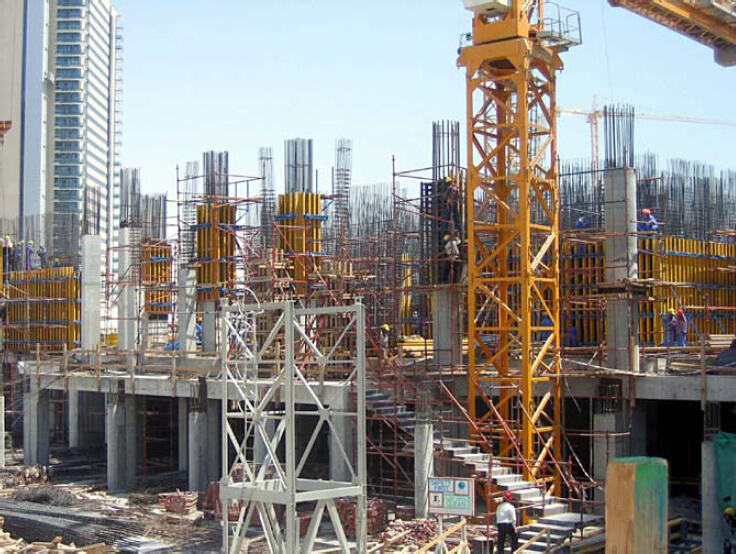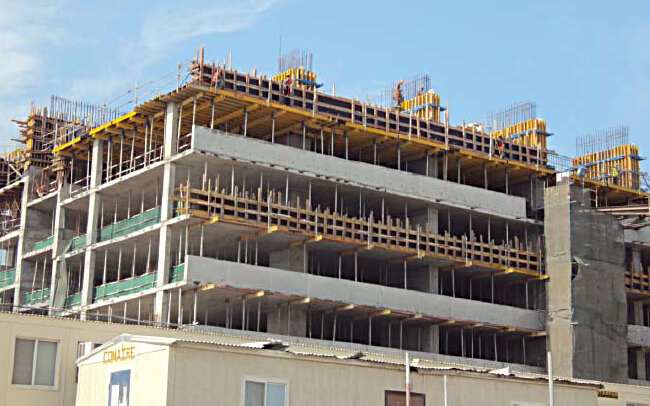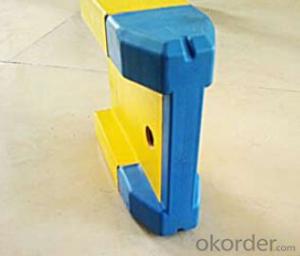Timber-beam Formwork for Building Construction
- Loading Port:
- Tianjin
- Payment Terms:
- TT OR LC
- Min Order Qty:
- 50 m²
- Supply Capability:
- 1000 m²/month
OKorder Service Pledge
Quality Product, Order Online Tracking, Timely Delivery
OKorder Financial Service
Credit Rating, Credit Services, Credit Purchasing
You Might Also Like
Characteristics:
◆ Standardized production lines.
Supply capability: 3000m/day, Lmax = 6600mm.
◆ Finger jointing of the flange and web, the strength of timber beam is highly improved.
Max. shearing force failure load:40KN
◆ Well treated to prevent from water penetration or erosion, so the service life maximally
extended.
Normally, CNBM timber beam H20 can be used for 4 to 5 years, the exact using time would
depend on maintenance & storage.
◆ Robust caps at the end of the girders protect against damages.


- Q:How does steel formwork affect the overall sound insulation of the structure?
- Steel formwork does not directly affect the overall sound insulation of a structure. The purpose of steel formwork is to provide temporary support and shape to the concrete during the construction process. It is primarily used for concrete walls, slabs, columns, and beams. The sound insulation of a structure is mainly determined by the materials used for walls, floors, and ceilings, as well as the design and construction techniques employed. These factors contribute to the transmission of sound waves and the overall acoustic performance of the building. While steel formwork itself does not have inherent sound insulation properties, it can indirectly affect the sound insulation of a structure during the construction phase. If the formwork is not properly installed or secured, it may result in gaps or cracks in the concrete, which can compromise the sound insulation performance of the finished structure. However, it is important to note that any potential impact on the sound insulation of the structure due to steel formwork is temporary and can be rectified during the subsequent stages of construction, such as by using suitable acoustic insulation materials or soundproofing techniques. In summary, steel formwork does not directly affect the overall sound insulation of a structure. The sound insulation of a building is primarily determined by the materials and construction techniques used for walls, floors, and ceilings. Proper installation and subsequent measures can address any temporary impact on sound insulation caused by steel formwork during the construction process.
- Q:How does steel formwork affect the overall thermal insulation of a building?
- Steel formwork has minimal impact on the overall thermal insulation of a building. Since steel is a good conductor of heat, it does not provide sufficient insulation on its own. However, when combined with appropriate insulation materials, such as foam or mineral wool, steel formwork can contribute to a well-insulated building by providing structural support while the insulation material retains heat or cold temperatures.
- Q:How does steel formwork handle different concrete reinforcement types?
- Steel formwork is a versatile and durable option for handling different types of concrete reinforcement. It is commonly used in construction projects to create temporary molds or structures to hold concrete in place during the pouring and curing process. One of the advantages of steel formwork is its ability to handle different concrete reinforcement types. Whether it is traditional reinforcement such as steel bars or modern reinforcement techniques like fiber-reinforced polymers (FRP), steel formwork can accommodate them all. Steel formwork is designed to be strong and rigid, which allows it to support the weight and pressure exerted by different types of reinforcement materials. Whether it is the weight of steel bars or the tensile strength of FRP, steel formwork can withstand these forces without deforming or collapsing. Additionally, steel formwork is highly adaptable and can be easily adjusted or modified to accommodate different reinforcement types. It can be cut or welded to create openings or recesses for steel bars or other reinforcement materials to pass through. This flexibility ensures that steel formwork can be customized to suit the specific needs of each construction project. Furthermore, steel formwork offers a smooth and even surface finish, which is crucial for ensuring proper adhesion between the concrete and the reinforcement materials. This ensures that the reinforcement is securely embedded within the concrete structure, providing the necessary structural integrity and strength. In conclusion, steel formwork is a reliable and effective solution for handling different concrete reinforcement types. Its strength, adaptability, and ability to provide a smooth surface finish make it an ideal choice for construction projects that require diverse reinforcement materials.
- Q:What are the different types of steel formwork systems?
- Construction projects commonly utilize various types of steel formwork systems, which serve as temporary structures or molds to support concrete during pouring and curing. Below are several types of steel formwork systems commonly used: 1. Traditional steel formwork: This prevalent system involves connecting individual steel panels using clamps or pins. These panels can be adjusted to create different shapes and sizes, and they are straightforward to assemble and disassemble. 2. Modular steel formwork: This system relies on prefabricated steel modules that are interconnected to form larger formwork assemblies. The modules are lightweight and easy to handle, making them ideal for repetitive use in projects with consistent shapes and sizes. 3. Tunnel formwork: Specifically designed for tunnel or underground structure construction, this system utilizes interconnected steel panels to create a seamless, continuous mold. It is commonly employed in large-scale infrastructure projects like subway systems or underground parking garages. 4. Climbing formwork: This system is suitable for tall structures such as high-rise buildings or towers. It comprises vertically extendable steel formwork panels that are attached to a climbing mechanism. This mechanism facilitates lifting and repositioning of the panels at each level, enabling uninterrupted construction. 5. Slip formwork: For vertical structures like walls or columns, slip formwork is utilized. It involves a moving formwork that is continuously filled with concrete as it ascends. Steel rods or cables support the formwork, allowing for the swift construction of tall and straight structures. These examples represent only a portion of the diverse steel formwork systems available. The selection of the most suitable system depends on the project's specific requirements, including structure size, shape, complexity, desired construction speed, and cost-effectiveness.
- Q:Can steel formwork be used for both interior and exterior concrete finishes?
- Indeed, both interior and exterior concrete finishes can make use of steel formwork. Renowned for its robustness and longevity, steel formwork proves to be fitting for diverse purposes. Whether it pertains to interior partitions, pillars, or external pavement, steel formwork ensures a seamless and uniform foundation for concrete pouring. Moreover, steel formwork lends itself to effortless customization and adaptability, enabling it to meet project specifications with ease. This versatility renders steel formwork an excellent option for both interior and exterior concrete finishes.
- Q:How does steel formwork contribute to the overall safety of the construction process?
- Steel formwork contributes to the overall safety of the construction process by providing a sturdy and stable structure for concrete pouring. Its strength and durability minimize the risk of accidents caused by collapsing or shifting formwork. Additionally, steel formwork is fire-resistant, reducing the likelihood of fire hazards on the construction site. Its reusable nature also reduces waste and potential environmental hazards, ensuring a safer working environment for construction workers.
- Q:What are the environmental benefits of using steel formwork?
- Using steel formwork for construction projects offers several environmental benefits. Firstly, steel formwork is reusable and durable, resulting in reduced waste generation compared to traditional timber formwork. This reduces the demand for timber resources, leading to a decrease in deforestation and the preservation of natural habitats. Moreover, the longevity of steel formwork means it has a longer lifespan, resulting in fewer replacements and less material consumption over time. Additionally, steel formwork can be easily recycled at the end of its life, reducing the burden on landfills and promoting a circular economy. Ultimately, the use of steel formwork contributes to sustainable construction practices, minimizing environmental impact and promoting resource efficiency.
- Q:Are all steel plates used for beam slab prefabrication
- Prefabricated components according to the number of times to determine the turnover, the same specifications of the components to reach more than 10, the general use of stereotypes steel template, the specification of the component is less, the general use of steel or steel formwork formwork
- Q:How does steel formwork contribute to the overall durability of the concrete structure?
- Steel formwork contributes to the overall durability of a concrete structure in several ways. Firstly, steel formwork provides a strong and rigid framework for pouring and shaping the concrete. This ensures that the concrete is properly supported during the curing process, preventing any deformation or collapse that could compromise the structure's integrity. Additionally, steel formwork is highly resistant to the corrosive effects of concrete, which contains alkaline substances that can slowly erode other materials over time. This resistance to corrosion ensures that the formwork remains stable and intact throughout the construction process, maintaining the shape and dimensions of the concrete elements. Moreover, steel formwork allows for precise and accurate construction, resulting in a concrete structure with consistent dimensions and smooth finishes. This precision minimizes the chances of structural weaknesses or flaws in the concrete, enhancing its overall durability. Furthermore, steel formwork is reusable, making it a cost-effective option for construction projects. By using steel formwork multiple times, the overall durability of the concrete structure is improved as the formwork retains its strength and stability over numerous applications. In conclusion, steel formwork plays a crucial role in enhancing the overall durability of a concrete structure. Its strength, resistance to corrosion, precision, and reusability ensure that the concrete is properly supported, accurately constructed, and able to withstand external forces, contributing to a long-lasting and robust structure.
- Q:Are there any specific considerations for using steel formwork in areas with high traffic loads?
- Yes, there are several specific considerations when using steel formwork in areas with high traffic loads. Firstly, the strength and durability of the steel formwork should be carefully evaluated to ensure that it can withstand the heavy loads and constant traffic. Steel formwork is known for its high strength and load-bearing capacity, making it suitable for such applications. However, it is important to choose the right type and grade of steel that can withstand the specific traffic loads in the area. Secondly, the design and construction of the formwork system should be done by experienced professionals who understand the requirements of high traffic loads. Proper reinforcement and bracing should be incorporated to provide additional strength and stability to the formwork structure. This may include using additional steel supports or beams to distribute the loads more effectively. Additionally, the connections and joints between different formwork elements should be carefully designed and constructed to ensure they can withstand the heavy traffic loads without any failure. Welding or bolting techniques may be used to enhance the structural integrity of the formwork system. Furthermore, regular inspection and maintenance of the steel formwork should be carried out to identify any signs of wear and tear or damage caused by the high traffic loads. Any damaged or weakened sections should be repaired or reinforced promptly to avoid any safety hazards. Lastly, it is important to consider the impact of the high traffic loads on the concrete being poured into the formwork. The concrete mix and pouring techniques should be carefully chosen to ensure they can withstand the dynamic loads caused by heavy traffic. Reinforcement measures such as using steel rebar or fiber reinforcement can also be considered to enhance the strength and durability of the concrete. In conclusion, when using steel formwork in areas with high traffic loads, it is essential to consider the strength and durability of the formwork, design and construction techniques, connections and joints, regular inspection and maintenance, as well as the impact on the concrete. By taking these specific considerations into account, the steel formwork can provide a safe and reliable solution for construction projects in high traffic areas.
1. Manufacturer Overview |
|
|---|---|
| Location | |
| Year Established | |
| Annual Output Value | |
| Main Markets | |
| Company Certifications | |
2. Manufacturer Certificates |
|
|---|---|
| a) Certification Name | |
| Range | |
| Reference | |
| Validity Period | |
3. Manufacturer Capability |
|
|---|---|
| a)Trade Capacity | |
| Nearest Port | |
| Export Percentage | |
| No.of Employees in Trade Department | |
| Language Spoken: | |
| b)Factory Information | |
| Factory Size: | |
| No. of Production Lines | |
| Contract Manufacturing | |
| Product Price Range | |
Send your message to us
Timber-beam Formwork for Building Construction
- Loading Port:
- Tianjin
- Payment Terms:
- TT OR LC
- Min Order Qty:
- 50 m²
- Supply Capability:
- 1000 m²/month
OKorder Service Pledge
Quality Product, Order Online Tracking, Timely Delivery
OKorder Financial Service
Credit Rating, Credit Services, Credit Purchasing
Similar products
New products
Hot products
Hot Searches























